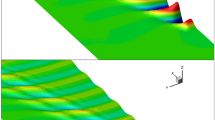Abstract
This paper discusses a rational and systematic procedure for understanding and analysing steady ship wave patterns and their dependence on hull form. A stepwise procedure is proposed in which the pressure distribution around the hull is invoked to provide a qualitative understanding of the connection between hull form and wave making. In a recent publication it was shown how this understanding explains various known trends and, in combination with wave pattern computations by free-surface potential flow or Reynolds-averaged Navier–Stokes (RANS) methods, can often be exploited to reduce wave making by modifying the hull form. The present paper provides support for the guidelines given, validates the decomposition into different steps and indicates the connection with previous theoretical approaches.















Similar content being viewed by others
References
Dawson CW (1977) A practical computer method for solving ship-wave problems. In: 2nd International Conference on Numerical Ship Hydrodynamics, Berkeley, USA
Jensen G (1988) Berechnung der stationären Potentialströmung um ein Schiff unter Berücksichtigung der nichtlinearen Randbedingung an der Wasseroberfläche. Ph.D. Thesis, University of Hamburg, IfS Bericht 484
Janson C-E (1997) Potential flow panel methods for the calculation of free-surface flows with lift. Thesis, Chalmers Univ. Gothenburg
Raven HC (1992) A practical nonlinear method for calculating ship wavemaking and wave resistance. In: 19th Symposium on Naval Hydrodynamics, Seoul, South Korea
Raven HC (1996) A solution method for the nonlinear ship wave resistance problem. PhD Thesis, MARIN/Delft University of Technology, The Netherlands
Janson C-E, Larsson L (1996) A method for the optimization of ship hull forms from a resistance point of view. In: 21st Symposium on Naval Hydrodynamics, Trondheim, Norway
Valdenazzi F, Harries S, Janson CE, Leer-Andersen M, Marzi J, Maisonneuve JJ, Raven HC (2003) The FANTASTIC RoRo: CFD optimisation of the forebody and its experimental verification. NAV 2003 Symposium, Palermo, Italy
Hoekstra M, Raven HC (2003) A practical approach to constrained hydrodynamic optimization of ships. NAV 2003 Symposium, Palermo, Italy
Larsson L, Raven HC (2010) Ship resistance and flow. In: Paulling JR (ed) Principles of naval architecture series. Society of Naval Architects and Marine Engineers (SNAME), Jersey City, USA
Raven HC (1988) Variations on a theme by Dawson. In: Proceedings of the 17th Symposium Naval Hydrodynamics, Den Haag, Netherlands
Raven HC (1998) Inviscid calculations of ship wavemaking—capabilities, limitations and prospects. In: 22nd Symposium Naval Hydrodynamics, Washington, DC, USA
Newman JN (1977) Marine hydrodynamics. MIT Press, Cambridge
Tuck EO, Scullen DC, Lazauskas L (2002) Wave patterns and minimum wave resistance for high-speed vessels. In: 24th Symposium on Naval Hydrodynamics, Fukuoka, Japan
Doctors LJ (1997) Optimal pressure distributions for river-based air-cushion vehicles. Schiffstechnik 44
Wehausen JV, Laitone EV (1960) Surface waves. In: Encyclopedia of Physics, vol IX, Springer, pp 446–778
Raven HC (1997) The nature of nonlinear effects in ship wavemaking. Ship Technol Res 44(1):134
Newman JN (1976) Linearized wave resistance theory. International Seminar on Wave Resistance, Tokyo/Osaka, Society of Naval Architects Japan
Baba E, Takekuma K (1975) A study on free-surface flow around bow of slowly moving full forms. J Soc Naval Archit Jpn 137:65–73
Baba E, Hara M (1977) Numerical evaluation of a wave-resistance theory for slow ships. In: 2nd International Conference on Numerical Ship Hydrodynamics, Berkeley, USA
Lighthill J (1980) Waves in fluids. Cambridge University Press, Cambridge
Hess JL, Smith AMO (1962) Calculation of non-lifting potential flow about arbitrary three-dimensional bodies. Douglas Aircraft Company, Report No. 40622
Toda Y, Stern F, Longo J (1991) Mean-flow measurements in the boundary layer and wake and wave field of a Series 60 C b = .6 ship model for Froude numbers .16 and .316. IIHR Report No. 352, Iowa Institute of Hydraulic Research, Iowa, USA
Acknowledgments
The permission from the Society of Naval Architects and Marine Engineers (SNAME) to reproduce some material from [9] in this paper is acknowledged.
Author information
Authors and Affiliations
Corresponding author
About this article
Cite this article
Raven, H.C. Validation of an approach to analyse and understand ship wave making. J Mar Sci Technol 15, 331–344 (2010). https://doi.org/10.1007/s00773-010-0102-1
Received:
Accepted:
Published:
Issue Date:
DOI: https://doi.org/10.1007/s00773-010-0102-1




